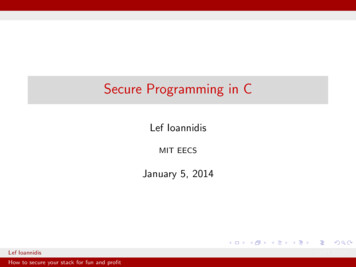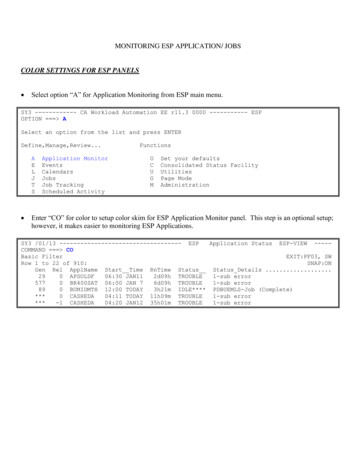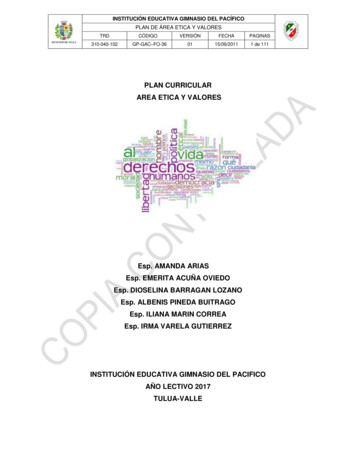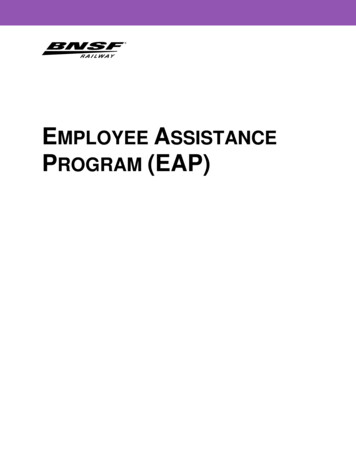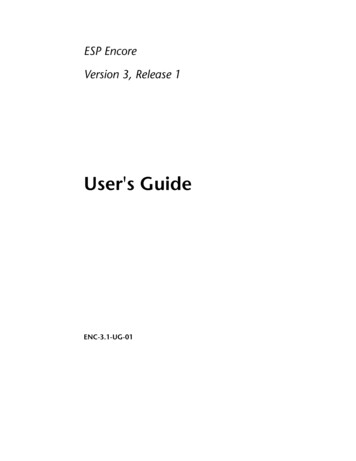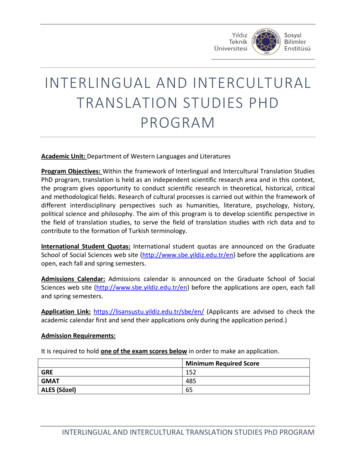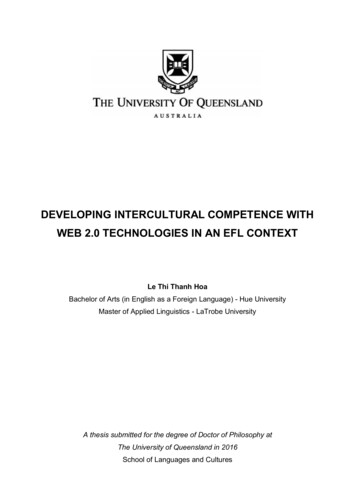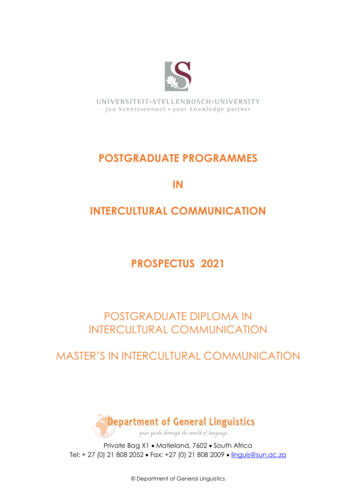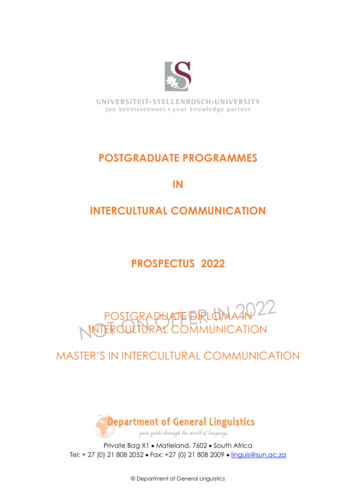
Transcription
Intercultural Rhetoric and ESP/EAPUlla Connor, PhDChancellor’s Professor of English, Indiana University-Purdue University IndianapolisBarbara E. and Karl R. Zimmer Chair in Intercultural CommunicationDirector, Indiana Center for Intercultural Communication (ICIC)uconnor@iupui.edu(317) 274-2555Center for English Language Communication (CELC) Symposium 2013National University of SingaporeMay 27-29, 2013
Overview Defining intercultural rhetoricCultureIntercultural rhetoric and ESP in practiceText studies 2013 Indiana Center for Intercultural Communication
From Contrastive to Intercultural Rhetoric “Contrastive rhetoric, started by Robert Kaplan (1966),is an area of research in second language acquisitionthat identifies problems in composition encounteredby second language writers and, by referring to therhetorical strategies of the first language, attempts toexplain them” (Connor, 1996, p. 5).– an applied linguistics field with a teaching concern– influenced by contrastive analysis– first real research interest in teaching writing to ESLlearners in the USA (vs. spoken language) 2013 Indiana Center for Intercultural Communication
Intercultural Rhetoric Intercultural rhetoric is defined as thestudy of discourse between and amongindividuals from different culturalbackgrounds.– Intercultural provides an appropriateconnotation of collaborative interactionbetween and among cultures, on one hand,and within cultures on the other (Connor,2011, p. 1). 2013 Indiana Center for Intercultural Communication
Intercultural Rhetoric “Intercultural rhetoric” is an umbrella term thatincludes cross-cultural studies (comparisons ofthe same concept in culture one and culture two)as well as studies of interactions in which writersfrom a variety of linguistic, cultural, and socialbackgrounds negotiate through speaking andwriting (Connor, 2011, p. 2). 2013 Indiana Center for Intercultural Communication
Three main premises ofIntercultural Rhetoric Texts must be seen in their full contexts Small and large cultures interact in complex ways Accommodation and negotiation is necessary inintercultural communicationSo how do we apply these premises in real-lifesituations? 2013 Indiana Center for Intercultural Communication
Chinese college student’s request forfinancial assistance from universityDear Professor :I am an engineer of Aerospace Research Institute of Materials & Processing Technology (ARIMT), China Academyof Launch Vehicle Technology and I am mainly engaging in the research and manufacture of the resin matrixcomposite products used for aerospace technology. A letter in January, 2004, from Jane Henderson,Director Graduate School Operations of University X, said that my application for the Ph.D. Program inMaterials Science was approved by the University X Graduate School. I am very happy about it and I cherishthis opportunity of learning and improvement. I hope to begin study and work as soon as possible. There isa question, however, it dose not specify my mentor in the Certificate of Application Review. On the groundof my research interest and job experience, I wish to engage in composite materials as an research assistantunder your direction during my Ph.D. Program. I look forward to your instruction and help.I acquired the Bachelor’s Degree of Polymer Engineering in 1995 ,The goal of my Ph.D. program is to study theadvanced theory and means, explore innovative molding technologies in order to acquire the firm base formy research of low-cost, high-performance and multi-functional composite materials in the future.The Materials Science and Engineering Department of University X has excellent research ability and facilitiesand the research group lead by you is the hardcore. So I am desired to join your team and get your advise.Thank you very much for your future help and look forward to hear from you soon.My student number is 888221735Yours Sincerely, 2013 Indiana Center for Intercultural Communication
Culture as a Burning Issue in the 21st Century Culture is one of the two or three most complex words in the language(Williams, 1983, p. 87) Early notions of culture, the “received view,” consider large groups assharing a definable culture (ethnic, national, international) Postmodern views see culture as “a dynamic, ongoing process whichoperates in changing circumstances to enable group members to makesense and meaningfully operate within those circumstances” (Holliday,1999, p. 248) Culture has become less and less a national consensus, but “aconsensus built on common ethnic, generational, ideological, occupation– or gender related interests, within and across national boundaries”(Kramsch, 2002, p. 276)
Small and Large Cultures(Holliday, 1994, 1999)Small CulturesLarge Cultures Nonessentialist,nonculturalist Essentialist, culturalist Relative to cohesivebehaviors in activities withinany social grouping “Culture” as essentialfeatures of ethnic, national,or international group No necessary subordinationto or containment withinlarge cultures Small (sub)culturescontained within andsubordinate to large cultures Interpretive process Normative, prescribed 2013 Indiana Center for Intercultural Communication
Large and Small Cultures in the ClassroomFigure 1: Interacting cultures in an educational setting [adapted from Holliday (1999) and Atkinson (2004)] 2013 Indiana Center for Intercultural Communication
IR and ESP in practice: Examples from the IndianaCenter for Intercultural Communication (ICIC) Intercultural communication, oral and written academicEnglish with American cultural experience for internationalfaculty and professionals from overseas in short-termintensive programs English for Specific Purposes (ESP) workshops forinternational faculty and researchers on the IUPUI campus Assessment and training for international medical residents 2013 Indiana Center for Intercultural Communication
ESP: VIED example Vietnam International Education Development (VIED) Consisted of seven weeks of English and teachingmethodology classes, including guest speakers andclassroom observations Large culture: Vietnamese Small cultures: DisciplinaryGenerationalGenderDegree level (Masters, Ph.D.)Region within Vietnam 2013 Indiana Center for Intercultural Communication
Culture from the bottom up Culture as represented in the lives of its individual users fromtheir perspectives– Cultural studies of the person– People live “culturally” Cultural nature of the individual– How sociocultural influences contribute to individual identity Individual nature of the cultural– How cultural material is actively interpreted, appropriated,and (re)created by individuals– Atkinson, 1999; Atkinson and Sohn, in press
Interaction and Accommodation(not Assimilation) Useful theories to develop IR– Speech accommodation (SAT) and laterCommunication accommodation theory (CAT)(Giles, Coupland & Coupland, 1991; Coupland &Jaworski, 1997) for intercultural encounters– Accommodation for mutual interculturalunderstanding (Connor, 1999, “How like you ourfish?”) in face-to-face situations
Accommodation in International BusinessCommunication (Connor, 1999)Sample messages by the broker in seller roleto a (1) Japanese and a (2) Swiss buyer 1. [Seller company name] has not yetreceived any payments of green roe. Couldyou please check what is causing the delaysor when it has been paid in Tokyo? 2. Good morning. We should have perchfillets for Wednesday shipment. Please letus know your needs. Prices are the same.Have a nice day!Sample messages sent to a Norwegian supplier 1. They are not using minced salmon but theywould like to look at the sample and possibility tosubstitute minced salmon trout. They are using alot of minced salmon trout. 2. They are not using minced salmon trout, butfeel that it is an interesting raw material. They aska sample to [Buyer company’s name] 3. They are introducing a new product based onminced salmon trout. They would like to study ifthey could use minced salmon as a substitute. 4. [Buyer company’s name] asked for the price of‘mandel fisk’ for next season. I have given [price]per kg. What you think? Next week we shouldreceive comments of your samples.
Text Analysis: Language and Writing asSocial Action Texts in contexts Genres as part of genre systems New methods of context-sensitive textanalysis including:– Corpus analyses– Semi-ethnographic approaches 2013 Indiana Center for Intercultural Communication
Text Analysis Methodologies in IR Corpus analysis– “Using computerized corpus analysis to investigate thetextlinguistic discourse moves of letters of application” (Upton &Connor, 2001) Contextualized text analysis – supplementing text analysiswith interviews, observations, and surveys– “Variation in rhetorical moves in grant proposals of US humanistsand scientists” (Connor, 2000) Ethnographic and other naturalistic approaches– “‘How like you our fish?’ Accommodation in internationalbusiness communication” (Connor, 1999) 2013 Indiana Center for Intercultural Communication
2013 Indiana Center for Intercultural Communication
Indiana Center for Intercultural Communication (ICIC), 2013
References Atkinson, D. (2004). Contrasting rhetorics/contrasting cultures: Why contrasting rhetoric needs a better conceptualizationof culture. Journal of English for Academic Purposes: Special Issue on Contrastive Rhetoric in EAP, 3(4), 277-289. Atkinson, D., & Sohn, J. (in press). Culture from the bottom-up. TESOL Quarterly. Belcher, D., & Nelson, G. (Eds.) (2013). Critical and corpus-based approaches to intercultural rhetoric. Ann Arbor, MI:University of Michigan Press. Connor, U. (1996). Contrastive rhetoric: Cross-cultural aspects of second language writing. Cambridge, UK: CambridgeUniversity Press. Connor, U. (1999). How like you our fish? Accommodation in international business communication. In M. Hewings & C.Nickerson (Eds.), Business English: Research into practice (pp. 115-128). Harlow, UK: Longman. Connor, U. (2000). Variation in rhetorical moves in grant proposals of US humanists and scientists. Text, 20(1), 1-28. Connor, U. (2011). Intercultural rhetoric in the writing classroom. Ann Arbor, MI: The University of Michigan Press. Coupland, N., & Jaworski, A. (1997). Relevance, accommodation, and conversation: Modeling the social dimension ofcommunication. Multilingua, 16(2-3), 235-258. Giles, H., Coupland, N., & Coupland, J. (1991). Accommodation theory: Communication, content, and consequence. In H.Giles, N. Coupland, & J. Coupland (Eds.), Contexts of accommodation: Developments in applied sociolingustics (pp. 1-68).New York: Cambridge University Press. Holliday, A. (1994). Appropriate methodology and social content. Cambridge, UK: Cambridge University Press. Holliday, A. (1999). Small cultures. Applied Linguistics, 20(2), 237-264. Kramsch, C. (2002). Language acquisition and language socialization: Ecological perspectives. London, UK: Continuum. Upton, T., & Connor, U. (2001). Using computerized corpus analysis to investigate the textlinguistic discourse moves of agenre. English for Specific Purposes: An International Journal, 20(4), 313-329. Williams, R. (1983). Keywords: A vocabulary of culture and society. London: Oxford University Press. 2013 Indiana Center for Intercultural Communication
Questions?For a copy of the PowerPoint or for further questions, icic
Ulla Connor, PhD Chancellor's Professor of English, Indiana University-Purdue University Indianapolis Barbara E. and Karl R. Zimmer Chair in Intercultural Communication Director, Indiana Center for Intercultural Communication (ICIC) uconnor@iupui.edu (317) 274-2555 Center for English Language Communication (CELC) Symposium 2013

